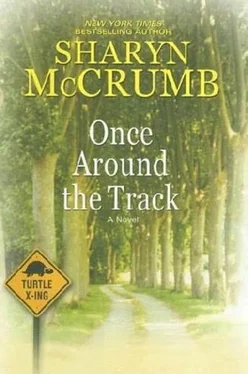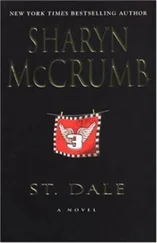“I wanted to get some pictures of myself for my portfolio,” he said. “And maybe to do an autograph card for local events.”
“Sure,” said Taran. “Where do you want to go?”
“Well, since there aren’t too many people around this afternoon, I was thinking Victory Lane.” He said it warily, as if he expected the statement to be met with peals of laughter, but everybody just nodded, seeing the logic of the suggestion.
“Come on,” said Taran. “If we take twenty or thirty shots, there’s bound to be one you can use.”
Victory Lane at Daytona is a large barred enclosure with a small set of bleachers facing a stage, whose white backdrop features the words “Daytona International Speedway” under a smaller design of multicolored flags. They walked from the garage area to the building that adjoined the Victory Lane enclosure, and a cleaning man obligingly let them in and pointed them to a door that opened into Victory Lane.
“How do I look?” asked Tony, as Taran positioned him on the stage under the word “Daytona.”
“Important,” said Taran. “Why don’t you stand over there beside the reflective glass wall of the building? If I angle the shot correctly, I can get the reflection of the track itself in the glass behind you.”
“That would be great,” said Tony.
About five minutes later, Taran was on the fifteenth variation of Tony in the reflection shot, when the tourist trolley arrived.
The Daytona International Speedway is a tourist attraction every day of the year. People come from all over the world to see the mother church of American racing, and part of the experience is getting to circle the track in a coupled caravan of open trolleys while a guide recites a running narrative of speedway history and information. One highlight of the tour is when the carriages go up on the steep banking between Turns Three and Four for perhaps fifty yards, enabling the tourists to experience the thrill of actually riding on the same part of the track where the race is run. After that the tour takes a five-minute break in Victory Lane-major photo opportunity.
This time when the guide unlocked the gate to Victory Lane, the crowd of tourists surged into the enclosure, whereupon sixty people simultaneously spotted the miraculous vision within: a NASCAR driver in a firesuit. As one, the horde of squealing spectators, which included a group of local schoolchildren, sprinted toward the exalted being posing for publicity pictures. Taking this as a signal that photos were indeed permitted, they encircled the driver and began clicking away. Others hung back, digging into pockets and purses for pens and scraps of paper on which to capture the celebrity’s autograph.
Tony bore up under this wave of adulation with remarkable grace and poise. He posed for pictures with anyone who wanted, and he motioned for all the fourth graders to encircle him so that he towered about them like an amiable Godzilla, smiling for a phalanx of amateur photographers. He shook hands and accepted hugs from admiring strangers, while Taran stood by wonderingly, and so totally ignored by Tony’s newfound admirers that she might have been invisible. He signed hats and hands and pieces of notebook paper. And posed for still more pictures.
And no one ever asked who he was.
After five minutes, the guide herded his charges back to the trolley to continue the tour, and waving their last farewells, the happy tourists climbed back on board and sped away up the track.
“Wow,” said Taran. “That was amazing. They treated you like you were Jeff Gordon.”
“It’s the firesuit,” said Tony. “It’s magic.”
“Yeah, I believe it. So…do you want to go over to Lake Lloyd? I could get some shots of you walking on water.”
When they got back to the 86 garage area, they were still laughing.
By Thursday, Tuggle had grudgingly pronounced them as ready as they were going to get. They hadn’t seen much of Badger. He had been whisked here and there, filming a NASCAR commercial with a couple of other drivers, giving interviews for the sports media, and renewing his acquaintance with all his old friends from his former days in Cup racing. He was due to turn up again late Thursday morning for the first autographing session promoting the Team Vagenya merchandise.
“I still don’t see why we agreed to this autographing,” said Sark with a worried frown. “Badger has the qualifying race this afternoon, doesn’t he?”
“He does,” said Tuggle. “That’s a couple of hours later.”
“But shouldn’t he be focusing on that? He can’t even get into the Daytona 500 unless he does well in this race. Why distract him?”
Tuggle shrugged. “Because these days, being popular is just about as important as winning. It impresses the sponsor, and it’s easier to achieve than a first-place finish.”
“But shouldn’t he concentrate on his actual job? He has to go around that track at two hundred miles per hour.”
“He’ll be fine,” said Tuggle. No point in telling the publicist that to the bosses it didn’t much matter whether he was fine or not. They could always get another wheel man.
Sark shrugged. Hers not to reason why. Because it was Badger’s first autographing as the Team Vagenya driver, they wanted her to photograph the event and to do a write-up for the team Web site, and so she would. Logistics were someone else’s problem. Sometimes Badger reminded her of Boxer the horse in Animal Farm : a hardworking simpleton exploited by the pigs of management. That observation might make an interesting sidebar for her exposé.
The lot where the souvenir trailers were parked-row on row of brightly painted vans, emblazoned with drivers pictures and team colors-reminded Sark of a state fairground. Here were the same kitschy souvenirs-the tee shirts, hats, and teddy bears-that you saw at the fairgrounds, and the same milling crowds of sartorially challenged sightseers. Only here, instead of the tattooed lady and the sword-swallower, people waited in line to meet a Cup driver. The difference, thought Sark, was that tattooed ladies and sword-swallowers made a living by letting people gawk at them, while presumably Cup drivers had better things to do. She resolved to make a note of that analogy for her future Vanity Fair article on the racing world. Ed Blair had called her on her cell phone that morning to ask how it was going.
“It’s not as outrageous as I expected,” she’d told him. “I’ve told you most of it in my e-mails. I know they haven’t been very detailed, but I’ve been too busy to write much. Everybody is pretty nice, though.”
“Keep digging,” he’d said. “You can make anybody look stupid if you put your mind to it.”
She eased her way through the crowd to the little wooden table where Badger sat ready to meet his public. He was wearing a purple Team Vagenya cap and tee shirt and a pair of faded Levis. She had expected to see him in his firesuit, but considering what a hot day it was, she supposed that his present outfit was a sensible choice, and the advertising logos meant that he was still promoting the brand.
A legion of race fans, predominantly female, stood in a disorderly line, cameras at the ready, waiting for the signal to surge forward. The signing had been an open invitation. Some drivers-possibly even Badger himself, for all she knew-were so popular that you had to get a ticket hours in advance just to be able to stand in their autograph line, but the team representative who had set up the event had not realized that Badger’s star shone quite so brightly, so all comers were welcome. It promised to be a free-for-all, because he could only stay for half an hour, and there seemed to be no way to accommodate the crowd in that length of time.
Читать дальше












